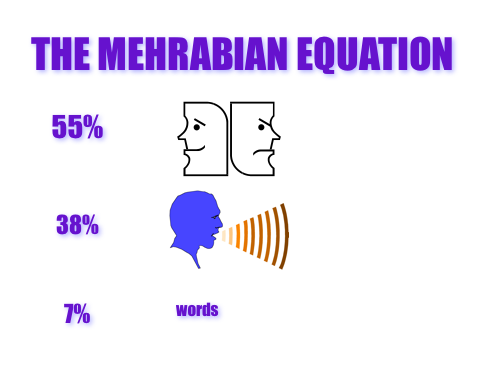Relative Influence of NVC Components
Think for a moment about the nonverbal behavior of students in a classroom and its potential impact on a teacher's motivation. As this quote from an article on NVC in instruction suggests,
"Some students sit upright in their chairs with a slight forward body lean. They maintain eye contact with their instructor while simultaneously nodding their heads and uttering vocal assurances. These nonverbal messages have been shown to stimulate, in our minds, meanings of attentiveness and responsiveness. These students are a pleasure to teach. Some students, however, sit in a slouching position with their heads bobbing back and forth, eyes closed, and snoring. These students are less than a pleasure to teach. Their nonverbal messages scream boredom, lack of interest, and apathy to name just a few.*"
Nonverbal signals such as these often remain outside of the sender's conscious awareness but it is clear that they are communicating something to the viewer.
While the nonverbal messages may be largely unintentional or uncontrollable, people (teachers included!) read a lot into them. In fact, we have a tendency to trust the nonverbal message being sent as the "real" message, especially when the verbal and nonverbal messages are incongruent. For example, if we ask a student if they understand a concept we've presented, and they verbally answer "yes" (verbal cue) but only after a pause (nonverbal cue) with a furrowed brow (nonverbal cue), and in a tentative sounding voice (nonverbal cue), we may conclude that in fact they actually didn't learn what we'd hoped they would. We sense that nonverbal messages are more trustworthy and authentic than the verbal ones.
The Mehrabian Equation - Congruence Matters
Social Psychology Professor Albert Mehrabian explored the relative impact of various channels of communication in terms of the power they have to convey our feelings and attitudes to others. 
Mehrabian's now well-known equation
(illustrated to the right - see his book Silent Messages, 1971 for more details) depicts the relative effectiveness of words alone compared to
the other non-verbal channels of voice and tonality and facial expressions and body language.
• 7% of message pertaining to feelings and attitudes is in the words that are spoken.
• 38% of message pertaining to feelings and attitudes is paralinguistic (the way that the words are said).
• 55% of message pertaining to feelings and attitudes is in facial expression.
Clearly, paying attention to our nonverbal communication and attempting to keep it consistent with our verbal message is important for delivering messages that communicate what we want them to.
Cautionary note: In the years since Mehrabian presented his findings they have been interpreted and represented in a variety of ways, sometimes not fully in keeping with his intentions or the scope of his research. For instance, concern has been raised that his work is being taken out of context to diminish the significance of the ACTUAL WORDS we choose to speak in favor of a focus mainly on nonverbals. A video is available online that presents some of these concerns. View it below, starting at the point where Mehrabian's equation is explained...
* Quoted text is from "Student Nonverbal Communication and Its Influence on Teachers and Teaching: A Review of Literature" by Mottet and Richmond. Available via ERIC - Document number ED447526
Licensed under the Creative Commons Attribution-NonCommercial-ShareAlike 2.5 License
Brought to you by CReducation.org.